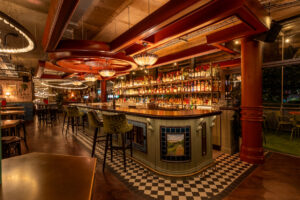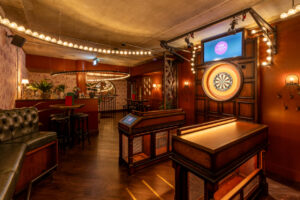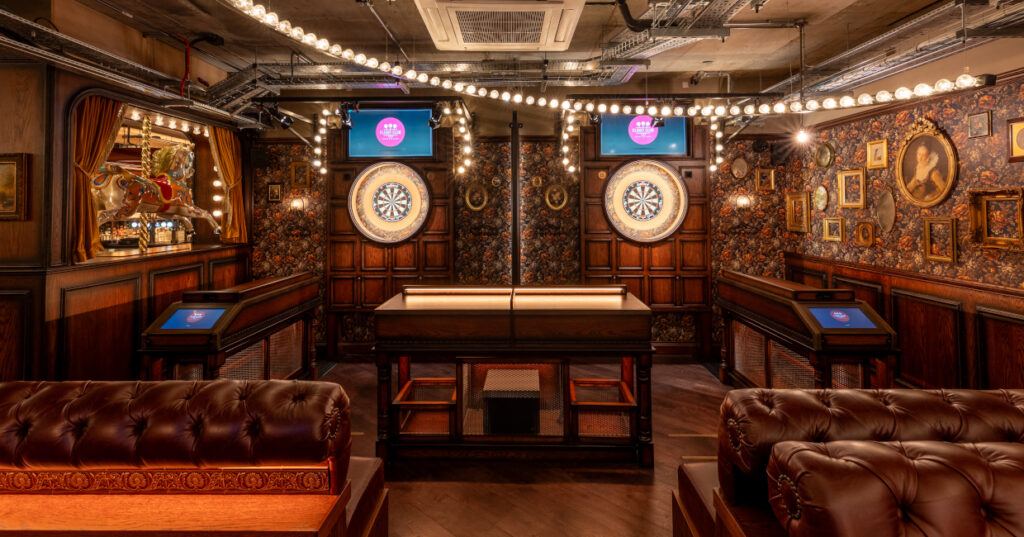Flight Club, owned and operated by hospitality group Red Engine, has opened its newest site in Liverpool. Located at the terrace level of the Liverpool ONE shopping centre, Flight Club Liverpool is the 13th UK opening for the bar brand.
The brand is on a mission to bring groups of friends together with its invention of the world’s first Social Darts experience, combined with craft cocktails and sharing dishes in a spectacular bar setting.
Visitors to the new Liverpool venue can expect semi-private oche areas arranged over two floors, two glorious bars, a ground-floor outdoor terrace, a mezzanine seating area overlooking all the action below, and a first-floor balcony looking out towards Chavasse Park.
Flight Club Liverpool was designed by Red Engine’s in-house interior design team. The main contractors for the project were 3i. The venue is 11,000 sq/ft, with 16 oches and a capacity of 400 people. It was previously occupied by Boujee Bar.
 The Brief: Cosiness and warmth with elements of surprise and delight
The Brief: Cosiness and warmth with elements of surprise and delightThe brief for the Red Engine design team on this project focussed on four key areas. First and foremost, to make a vast space with double-height ceilings and 5m high windows across the full exterior of the building feel warm and cosy. The light from these huge windows also presented a problem with how the Social Darts camera technology would function (cameras track the darts being thrown at each oche to automatically score them).
Second, to create a main bar with serious impact. Part of this area in the venue is tucked underneath a mezzanine, so the team had to come up with a bar design that wouldn’t get lost, that would have a big presence as you enter.
As with all Flight Club venues, a key element of the brief for the latest opening was to successfully convey the visual identity of the brand. Part of that includes creating moments of unexpected, ridiculous, joy throughout the space by adding standout features from big eye-catching installations to tiny details. Flight Club’s brand identity takes inspiration from the fairground, the British pub and the Victorian Age – because of their connections to the origins and history of the game of darts.
Lastly, the scheme, as with all Flight Club design schemes, needed to weave in nods to the heritage of the location.
 Design highlights: Fairground nostalgia and British eccentricity
Design highlights: Fairground nostalgia and British eccentricity Highlights of the design include a striking main bar complete with a wavy fairground lighting canopy that wraps around the building’s supporting columns, for drama and impact. Tiled arches with bronzed mirrored backs feature along the rear of the main bar, and padded leather panels finish the front.
The addition of full-height mechanical timber Venetian-style blinds control the light coming in, both supporting the venue’s technology needs, but also helping to create a darker, more intimate vibe. Installing Flight Club’s signature fairground ring lights at staggered heights throughout the space creates the illusion of a lower ceiling.
An earthy colour palette of deep greens and reds envelope the space and the use of brick slips with a variety of wallpaper prints add layers of warmth. Dark timber and panelling provide further depth and texture.
The mezzanine level offers moments of exciting and playful discovery. A spiral staircase leads up to a standalone oche, giving a sense of exclusivity and privacy while still feeling connected to the main space; all of the action below can be viewed via a circular portal window. Adding a sense of fun and intrigue to the space, the walls have been dressed with cheeky wallpaper that can be activated with an app to reveal some interesting moving images.
Up the staircase to the first floor, walls are adorned with grandfather clocks and other clocks of varying sizes.
On the first floor, a second bar awaits, featuring an open back bar made up of scaffolding shelving that looks out to the balcony terrace and Chavasse Park in the background. A decorative ceiling raft above the bar adds another level of interest, while the front of the first-floor bar is finished with tongue and groove panelling, creating a warm and welcoming atmosphere.
A red telephone box that has been transformed into a disco booth provides a moment of unexpected joy for guests. Customers can step inside, pick up the handset and dial for their favourite tune.
Victorian-style paintings, etchings and murals depicting Liverpool landmarks can be found throughout, including a hot air balloon mural painted by a scenic artist. Scenic bar panels take influence from the local area with Sefton Park and Liverpool Botanical Gardens referenced, as well as an area inspired by local beaches such as Crosby Beach.
To the exterior, huge Flight Club signage has been installed to activate the glazed elevation, and a Corten Steel effect canopy featuring fairground bulbs across its length and width sits above the entrance, making a statement as customers arrive.



